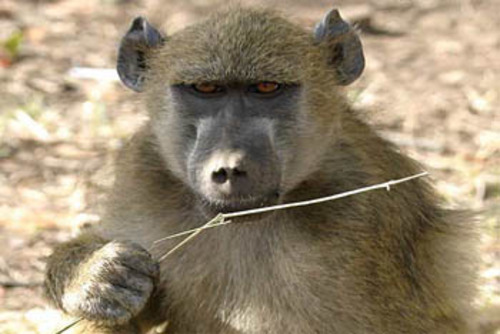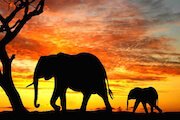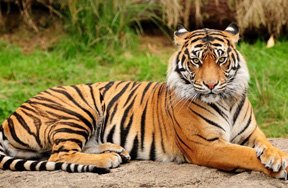Africa is a huge continent that’s made up of many different habitats, including sand, rock, water and grass. Each of those habitats is the perfect place for all sorts of cool creatures to live. Get to know some of the awesome animals of Africa!
Rock: The Ethiopian Highlands
Millions of years ago a volcano erupted and made a huge dome 620 miles wide. This mountain range is called the Ethiopian Highlands. During the rainy season, many rare animals feed off the grass and plants that grow among the rocks.
- Ethiopian Wolf: This carnivore (meat-eater) lives in pairs or small groups. Every morning the pack gathers for a noisy greeting ceremony. Then they start hunting for small mammals to eat during the day. Their long, thin snouts (noses) are perfect for sniffing out rats. These wolves are only found in Ethiopia, and there are only 500 left in the wild.
 Ethiopian Wolf
Ethiopian Wolf
- Gelada Baboon: With the strongest fingers of any primate, this baboon is a great climber and lives in grass-eating groups of up to 800 baboons. At night, they sleep together on rocky cliffs to avoid predators.
 Gelada Baboon
Gelada Baboon
- Walia Ibex: This rare goat species grazes in groups, so they can alert each other if there’s any sign of danger. Their rubbery hooves have hollow middles that act like suction cups to help the walia jump between rocks.
 Walia Ibex
Walia Ibex
Grass: The Savanna
Grass is the main plant of the Savanna’s ecosystem. This grass provides food for the hundreds of species of herbivores (plant-eaters) that roam across the African Savanna.
- Red-Billed Quelea: This small bird has a huge effect on its habitat. The birds cluster in flocks that can number in the thousands. At dawn, the flock searches for seeds and, by sunset, some farmers may find themselves without any crops left!
 Red-billed Quelea
Red-billed Quelea
- Wildebeest: Also called gnus, herds of wildebeest start migrating across Africa in May, walking up to 2,000 miles every single year. Throughout their trip, the animals’ hooves spread grass seeds and fertilize the ground, feeding birds and bugs.
 Wildebeest
Wildebeest
- Hyena: These carnivores leave their cubs at home for as long as four days at a time to find food. Hyenas can digest even the toughest parts of an animal, leaving behind few scraps for scavengers.
 Hyena
Hyena
Sand: The Deserts
Africa is home to the largest desert on earth – the Sahara. It’s also home to the Namib Desert and the Kalahari. The climate is harsh, with high air temperatures and little rain. Animals in the desert have adapted to survive this tough environment.
- Dromedary Camel: These camels store fat, not water, in their one humps, and can survive for days without anything to drink. But once they find water, dromedaries can gulp down 30 gallons in just a few minutes – a trick that would kill other animals. Dromedaries have furry ears, hairy nostrils and two layers of long, curly eyelashes any girl would KILL for! During a desert sandstorm, which can raise up walls of dust a mile high, dromedaries shut their ears, noses and eyes.
 Dromedary Camel
Dromedary Camel
- Augrabies Flat Lizard: These lizards live along the Orange River, which flows through the Kalahari Desert. Because the river attracts so many bugs and flies, the lizards can catch up to 17 flies per minute! At sunset, these cold-blooded reptiles squeeze between rocks, where it’s still warm.
 Augrabies Flat Lizard
Augrabies Flat Lizard
- South African Onyx: Also called a gemsbok, these animals move across the Namib desert in herds of 10-30. When a predator approaches, the herd circles its calves with horns facing out. To survive the heat, the onyx can make itself stop sweating in order to conserve water.
 Onyx or Gemsbok
Onyx or Gemsbok
- Namib Lion: These lions have adapted to the desert environment by absorbing almost all the moisture they need from their prey, the Oryx. In fact, desert lions can survive for two or three weeks without drinking water.
 Namib Lion
Namib Lion
- Namib Elephant: Africa’s largest herbivore survives in the desert by digging deep to find juicy, succulent plant roots. Their smaller bodies save water and their large ears are filled with blood vessels that spread the heat around their bodies evenly to keep the elephants cool as they search for new water holes.
 Namib Elephant
Namib Elephant
Water: The Rivers
During the dry season, herds of animals walk miles to find water. Africa is home to the planet’s largest freshwater lakes: Malawi, Tanganyika and Victoria It’s also home to the longest river in the world, the Nile.
- Nile Crocodile: These crocs can grow up to 16 feet long, and like to hide along the river’s edge, waiting for dinner to walk their way. Even so, it can take a crocodile up to an hour to drown a powerful Wildebeest.
 Nile Crocodile
Nile Crocodile
- Chacma Baboon: These scavengers eat fruit, bugs and seeds. They are the largest and heaviest baboon species in the world. It’s hard for them to walk upright, but they must do it in order to cross a flooded river. In fact, no member of the group, young or old, would ever be left behind.
 Chacma Baboon
Chacma Baboon
Related Stories:

































